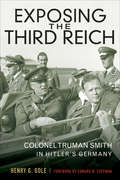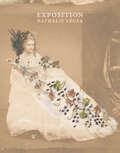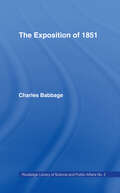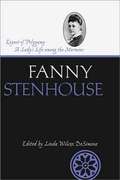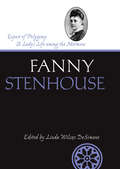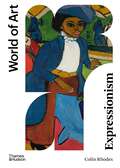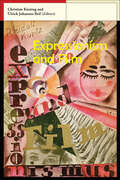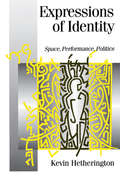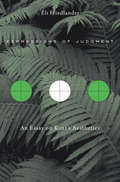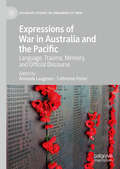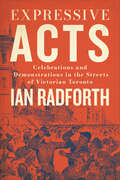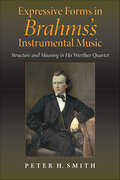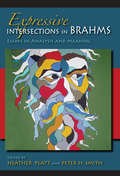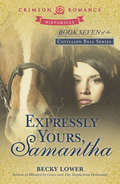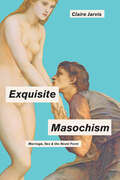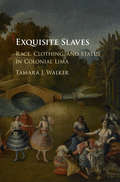- Table View
- List View
Exposing the Real Che Guevara: And the Useful Idiots Who Idolize Him
by Humberto FontovaThe perfect conservative contrast to the upcoming movie about Che. Hollywood, Madison Avenue, and the mainstream media celebrate Ernesto ?Che? Guevara as a saint, a sex symbol, and a selfless martyr. But their ideas about Che ? whose face adorns countless T-shirts and posters ? are based on the lies of Fidel Castro?s murderous dictatorship. Che?s hipster fans are classic ?useful idiots,? the name Stalin gave to foolish Westerners who parroted his lies about communism. And their numbers will only increase after a new biopic is released this fall, starring Benicio Del Toro. But as Humberto Fontova reveals in this myth-shattering book, Che was actually a bloodthirsty executioner, a military bumbler, a coward, and a hypocrite. In fact, Che can be called the godfather of modern terrorism. Fontova reveals: ? How he longed to destroy New York City with nuclear missiles. ? How he persecuted gays, blacks, and religious people. ? How he loved material wealth and private luxuries, despite his image as an ascetic. Are Che fans like Angelina Jolie, Jesse Jackson, Carlos Santana, and Johnny Depp too ignorant to realize they?ve been duped? Or too anti-American to care? .
Exposing the Third Reich: Colonel Truman Smith in Hitler's Germany (American Warriors Series)
by Henry G. Gole&“A fascinating book about a virtually unknown officer who played a major role in the development of US military planning before and during World War II&” (Bowling Green Daily News). A vital source of American intelligence on Hitler&’s rise to power and military ambitions, Colonel Truman Smith was one of the most compelling and controversial figures of the Second World War. In Exposing the Third Reich, Henry G. Gole tells this soldier's story for the first time. An American aristocrat from a prominent New England family, Smith became an expert on Germany when he was first assigned there during the Allied occupation of 1919. As a military attaché in 1935, he arranged for his good friend Charles Lindbergh to inspect the Luftwaffe. The Germans were starstruck by the famous aviator, enabling Smith to gather key intelligence about their air capability. His deep access and knowledge made him invaluable to General George C. Marshall; however, the colonel's friendliness with Germany also aroused suspicion that he was a Nazi sympathizer. Gole demonstrates that, far from condoning Hitler, Smith was among the first to raise the alarm: he predicted many of the Nazis' moves years in advance and feared that the international community would not act quickly enough. Featuring many firsthand observations of the critical changes in Germany between the world wars, this biography presents an indispensable look both at a fascinating figure and at the nuances of the interwar years.
Exposition
by Nathalie LégerThe first in Nathalie Léger&’s acclaimed genre-defying triptych of books about the struggles and obsessions of women artists. Exposition is the first in a triptych of books by the award-winning writer and archivist Nathalie Léger that includes Suite for Barbara Loden and The White Dress. In each, Léger sets the story of a female artist against the background of her own life and research—an archivist's journey into the self, into the lives that history hides from us. Here, Léger's subject is the Countess of Castiglione (1837–1899), who at the dawn of photography dedicated herself to becoming the most photographed woman in the world, modeling for hundreds of photos, including &“Scherzo di Follia,&” among the most famous in history. Set long before our own &“selfie&” age, Exposition is a remarkably modern investigation into the curses of beauty, fame, vanity, and age, as well as the obsessive drive to control and commodify one's image.
Exposition Park (The Driftless Series)
by Roberto TejadaImagine a walking tour of stanzas and prose poems that give lyric voice to sight, public speech, and spectacle. In Exhibition Park, Roberto Tejada delivers a command performance in mixed genres that compel an array of literary styles. His poetry undertakes a wide range of subjects motivated by artworks from Latin America and the United States covering the colonial period to the present day. In serial poems, short sketches, guidebook parodies, painterly triptychs, translations, and other word-based dioramas, Tejada coins wonder with historical styles--baroque, classic, and experimental. As likened to a world's fair, the resulting voices intone global stories, the dream life of art, and first-person atmospheres both premodern and postindustrial. "Tejada's work is with dismantling borders and upsetting classifications... The result is a layered poetry that finds its form in dense stanzas composed of lines that frequently veer toward a kind of fractured prose..."--Alan Gilbert in Another Future: Poetry and Modern Art in a Postmodern Twilight"You walk through his world as a voyeur, a traveler of mirrors, witnessing your own reflection in the masses of flesh, simultaneously aroused and disturbed at the same time. Tejada's work is an invitation, a window into another world, unabashedly erotic, and succinct."--Christine Lark Fox, Poetry Project Newsletter, about Mirrors for Gold
Exposition of 1851: Or Views of the Industry, The Science and the Government of England (Cambridge Library Collection - British And Irish History, 19th Century Ser.)
by Charles BabbagePart of the library of Science and Public Affairs and originally published in 1851, this study relates views of the industry, science and the Government of England in 1851.
Exposure: Poisoned Water, Corporate Greed, And One Lawyer's Twenty-year Battle Against Dupont
by Robert BilottERIN BROCKOVICH meets SILENT SPRING in this astounding true story of a lawyer who spent two decades building a case against one of the world’s largest chemical companies, uncovering a shocking history of environmental pollution and heartless cover-up. The story that inspired the forthcoming motion picture from Participant Media/Focus Features, starring Mark Ruffalo, Anne Hathaway, Bill Pullman and Tim Robbins, directed by Todd Haynes. In 1998, Robert Bilott was a 33-year-old Cincinnati lawyer on the verge of making partner when his career and life took an unforeseen turn. He was taken by surprise when he received a call from a man named Earl Tennant, a farmer from West Virginia with a slight connection to Robert’s family. Earl was convinced the creek on his property, where his cattle grazed, was being poisoned by run-off from a neighbouring factory landfill. His cattle were dying in hideous ways, and he hadn’t even been able to get a water sample tested by local agencies, politicians or vets. As soon as they heard the name DuPont – the area’s largest employer – he felt they were reluctant to investigate further. Once Robert saw the thick, foamy water that bubbled into the creek, the gruesome effects it seemed to have on livestock, and the disturbing frequency of cancer and lung problems in the surrounding area, he was persuaded to fight against the type of corporation his firm routinely represented. With all the cards stacked against him, Rob happened upon a stray reference in a random memo to a chemical called PFOA – a substance he’d never heard of that is used in the manufacture of Teflon. From that one reference, he ultimately gained access to 110,000 pages of DuPont documents, some of them fifty years old, that reveal decades of medical studiesproving the harmful – more often than not fatal – effects of PFOA in animals and humans. And yet PFOA sludge had still been dumped into rivers and landfill, endangering many lives. The case of one farmer soon spawns a class-action suit and the shocking realisation that virtually every person on the planet has been exposed to PFOA and carries the chemical in his or her blood.This is the unforgettable story of the lawyer who worked tirelessly for twenty years to get justice for all those who had suffered because of this chemical.
Exposé
by Saranne DawsonIN-DEPTH, EXCLUSIVE AND VERY INTIMATEHe was daring, dangerous, devious-and her ex-husband!Like a flash, wonderboy reporter Sam Winters stormed back into Kate Stevens's life-and under the conjugal roof. But Kate was on to the biggest story of her career, tracking a cunning lobbyist and a corrupt politician-one of whom wanted her dead.Sam claimed he was dead set on protecting her, but Kate knew he would do anything for a story, including steal it from her. Could his open arms and deep blue eyes be telling the truth this time?As the pieces of her story fit together, Kate didn't know whether her biggest power play of all would be with sexy Sam or the Washington honchos. Only one of them could be trusted.
Exposé of Polygamy
by Linda Wilcox Desimone Fanny StenhouseAfter the 1872 publication of Exposé, Fanny Stenhouse became a celebrity in the cultural wars between Mormons and much of America. An English convert, she had grown disillusioned with the Mormon Church and polygamy, which her husband practiced before associating with a circle of dissident Utah intellectuals and merchants. Stenhouse's critique of plural marriage, Brigham Young, and Mormonism was also a sympathetic look at Utah's people and honest recounting of her life. She later created a new edition, titled "Tell It All," which ensured her notoriety in Utah and popularity elsewhere but turned her thoughtful memoir into a more polemical, true exposé of Polygamy. Since 1874, it has stayed in print, in multiple, varying editions. The original book, meanwhile, is less known, though more readable. Tracing the literary history of Stenhouse's important piece of Americana, Linda DeSimone rescues an important autobiographical and historical record from the baggage notoriety brought to it.
Exposé of Polygamy: A Lady's Life Among the Mormons (Life Writings Frontier Women #1)
by Fanny StenhouseAfter the 1872 publication of Expose',Fanny Stenhouse became a celebrity in the cultural wars between Mormons and much of America. An English convert, she had grown disillusioned with the Mormon Church and polygamy, which her husband practiced before associating with a circle of dissident Utah intellectuals and merchants. Stenhouse’s critique of plural marriage, Brigham Young, and Mormonism was also a sympathetic look at Utah’s people and honest recounting of her life. Before long, she created a new edition, titled "Tell It All," which ensured her notoriety in Utah and popularity elsewhere but turned her thoughtful memoir into a more polemical, true expose' of Polygamy. Since 1874, it has stayed in print, in multiple, varying editions. The original book, meanwhile, is less known, though more readable. Tracing the literary history of Stenhouse’s important piece of Americana, Linda DeSimone rescues an important autobiographical and historical record from the baggage notoriety brought to it.
Expressionism
by Mary Whittall Wolf-Dieter DubeThe story of this decisive and immensely rich contribution to the history of twentieth-century art is told here by a senior curator of the Bavarian State Art Collection, largely in the vivid and intensely revealing words of the artists themselves.
Expressionism (World of Art)
by Colin RhodesA new comprehensive overview of expressionism, tracing its evolution from the nineteenth century to the present day. Expressionist artists believed in art's ability to communicate emotion, irrespective of any representational or narrative content. In this comprehensive introduction to one of the most radical artistic movements of our time, writer, artist, curator, and educator Colin Rhodes traces the thread of expressionist thought from the nineteenth century to the present day, mapping its various manifestations across Europe and the US, as well as parts of Africa, Asia, and South America. By paying particular attention to nuanced issues of gender, sexuality, and cultural appropriation, Rhodes challenges the received art-historical narrative and reassesses it in the context of broader twentieth- and twenty-first-century artistic practice. Generously illustrated, the diverse selection of artists featured in this book range from Wassily Kandinsky, Erma Bossi, Francis Bacon, and Mark Rothko to Ursula Schultze-Bluhm, Gillian Ayres, Purvis Young, and Jadé Fadojutimi.
Expressionism and Film
by Rudolf KurtzExpressionism and Film, originally published in German in 1926, is not only a classic of film history, but also an important work from the early phase of modern media history. Written with analytical brilliance and historical vision by a well-known contemporary of the expressionist movement, it captures Expressionism at the time of its impending conclusion—as an intersection of world view, resoluteness of form, and medial transition. Though one of the most frequently-cited works of Weimar culture, Kurtz's groundbreaking work, which is on a par with Siegfried Kracauer's From Caligari to Hitler and Lotte Eisner's The Haunted Screen, has never been published in English. Its relevance and historical contexts are analyzed in a concise afterword by the Swiss scholars Christian Kiening and Ulrich Johannes Beil.
Expressions of Identity: Space, Performance, Politics (Published in association with Theory, Culture & Society)
by Kevin HetheringtonThis innovative book sets out to question what we understand by the term `new social movements'. By examining a range of issues associated with identity politics and alternative lifestyles, the author challenges those who treat new social movements as instances of wider social change while often ignoring their more `local' and `dispersed' importance. This book questions what it means to adopt an identity that is organised around issues of expressivism - and offers a series of non-reductionist ways of looking at identity politics. Hetherington analyzes expressive identities through issues of performance, spaces of identity and `the occasion'. This important work shows how the significance of identity politics are at once local, plural, situated and topologically complex.
Expressions of Judgment: An Essay on Kant's Aesthetics
by Eli FriedlanderKant's The Critique of Judgment laid the groundwork of modern aesthetics when it appeared in 1790. Eli Friedlander's reappraisal emphasizes the internal connection of judgment and meaning, showing how the pleasure in judging is intimately related to our capacity to draw meaning from our encounter with beauty.
Expressions of Judgment: An Essay on Kant's Aesthetics
by Eli FriedlanderThe Critique of Judgment-the third and final work in Kant's critical system-laid the groundwork of modern aesthetics when it appeared in 1790. Eli Friedlander's reappraisal of this seminal accomplishment reformulates and elucidates Kant's thought in order to reveal the inner unity of the Third Critique. Expressions of Judgment emphasizes the internal connection of judgment and meaning in Kant's aesthetics, showing how the pleasure in judging is intimately related to our capacity to draw meaning from our encounter with beauty. Although the meaningfulness of aesthetic judgment is most evident in the response to art, the appreciation of nature's beauty has an equal share in the significant experience of our world. Friedlander's attention to fundamental dualities underlying the Third Critique-such as that of art and nature-underscores how its themes are subordinated systematically to the central task Kant sets himself: that of devising a philosophical blueprint for the mediation between the realms of nature and freedom. This understanding of the mediating function of judgment guides Friedlander in articulating the dimensions of the field of the aesthetic that opens between art and nature, the subject and the object, knowledge and the will, as well as between the individual and the communal. Expressions of Judgment illuminates the distinctness as well as the continuity of this important late phase in Kant's critical enterprise, providing insights for experienced scholars as well as new students of philosophy.
Expressions of War in Australia and the Pacific: Language, Trauma, Memory, and Official Discourse (Palgrave Studies in Languages at War)
by Catherine Fisher Amanda LaugesenThis edited book includes chapters that explore the impact of war and its aftermath in language and official discourse. It covers a broad chronological range from the First World War to very recent experiences of war, with a focus on Australia and the Pacific region. It examines three main themes in relation to language: the impact of war and trauma on language, the language of war remembrance, and the language of official communications of war and the military. An innovative work that takes an interdisciplinary approach to the themes of war and language, the collection will be of interest to students and scholars across linguistics, literary studies, history and conflict studies.
Expressive Acts: Celebrations and Demonstrations in the Streets of Victorian Toronto
by Ian RadforthIn nineteenth-century Toronto, people took to the streets to express their jubilation on special occasions, such as the 1860 visit of the Prince of Wales and the return in 1885 of the local Volunteers who helped to suppress the Riel resistance in the North-West. In a contrasting mood, people also took to the streets in anger to object to government measures, such as the Rebellion Losses bill, to heckle rival candidates in provincial election campaigns, to assert their ethno-religious differences, and to support striking workers. Expressive Acts examines instances of both celebration and protest when Torontonians publicly displayed their allegiances, politics, and values. The book illustrates not just the Victorian city’s vibrant public life but also the intense social tensions and cultural differences within the city. Drawing from journalists’ accounts in newspapers, Expressive Acts illuminates what drove Torontonians to claim public space, where their passions lay, and how they gave expression to them.
Expressive Forms in Brahms's Instrumental Music: Structure and Meaning in His Werther Quartet (Musical Meaning and Interpretation)
by Peter H. Smith"This book is a substantial and timely contribution to Brahms studies. Its strategy is to focus on a single critical work, the C-Minor Piano Quartet, analyzing and interpreting it in great detail, but also using it as a stepping-stone to connect it to other central Brahms works in order to reach a new understanding of the composer's technical language and expressive intent. It is an original and worthy contribution on the music of a major composer." —Patrick McCrelessExpressive Forms in Brahms's Instrumental Music integrates a wide variety of analytical methods into a broader study of theoretical approaches, using a single work by Brahms as a case study. On the basis of his findings, Smith considers how Brahms's approach in this piano quartet informs analyses of similar works by Brahms as well as by Beethoven and Mozart.Musical Meaning and Interpretation—Robert S. Hatten, editor
Expressive Intersections in Brahms: Essays in Analysis and Meaning (Musical Meaning And Interpretation Ser.)
by Heather Platt and Peter H. Smith&“This exceptionally fine collection brings together many of the best analysts of Brahms, and nineteenth-century music generally, in the English-speaking world today.&” —Nineteenth-Century Music Review Contributors to this exciting volume examine the intersection of structure and meaning in Brahms&’s music, utilizing a wide range of approaches, from the theories of Schenker to the most recent analytical techniques. They combine various viewpoints with the semiotic-based approaches of Robert Hatten, and address many of the most important genres in which Brahms composed. The essays reveal the expressive power of a work through the comparison of specific passages in one piece to similar works and through other artistic realms such as literature and painting. The result of this intertextual re-framing is a new awareness of the meaningfulness of even Brahms&’s most &“absolute&” works. &“Through its unique combination of historical narrative, expressive content, and technical analytical approaches, the essays in Expressive Intersections in Brahms will have a profound impact on the current scholarly discourse surrounding Brahms analysis.&” —Notes
Expressivism, Pragmatism And Representationalism
by Michael Williams Simon Blackburn Huw Price Robert BrandomPragmatists have traditionally been enemies of representationalism but friends of naturalism, when naturalism is understood to pertain to human subjects, in the sense of Hume and Nietzsche. In this volume Huw Price presents his distinctive version of this traditional combination, as delivered in his Ren Descartes Lectures at Tilburg University in 2008. Price contrasts his view with other contemporary forms of philosophical naturalism, comparing it with other pragmatist and neo-pragmatist views such as those of Robert Brandom and Simon Blackburn. Linking their different 'expressivist' programmes, Price argues for a radical global expressivism that combines key elements from both. With Paul Horwich and Michael Williams, Brandom and Blackburn respond to Price in new essays. Price replies in the closing essay, emphasising links between his views and those of Wilfrid Sellars. The volume will be of great interest to advanced students of philosophy of language and metaphysics.
Expressly Yours, Samantha
by Becky LowerSamantha Hughes has one day to escape from her wicked uncle, and a sign in the post office is her answer. She'll cut her hair to pose as a man and become Sam Hughes, a Pony Express rider.Valerian Fitzpatrick doesn't want the weight of responsibility that his brothers have in the family business. Fortunately, the Pony Express offers a chance to make his own way in the world.He assumes his new buddy, Sam, is on the run from the law, until she's hit by a stray gunshot and he has to undress her to staunch the wound. Friendship quickly turns to attraction - and more - but when Sam's uncle tracks her down, she is forced to run yet again.Val's determined to find her, but will a future with Sam mean giving up the freedom he's always craved?Sensuality Level: Sensual
Expressly Yours, Samantha
by Becky LowerSamantha Hughes has one day to escape from her wicked uncle, and a sign in the post office is her answer. She'll cut her hair to pose as a man and become Sam Hughes, a Pony Express rider.Valerian Fitzpatrick doesn't want the weight of responsibility that his brothers have in the family business. Fortunately, the Pony Express offers a chance to make his own way in the world.He assumes his new buddy, Sam, is on the run from the law, until she's hit by a stray gunshot and he has to undress her to staunch the wound. Friendship quickly turns to attraction - and more - but when Sam's uncle tracks her down, she is forced to run yet again.Val's determined to find her, but will a future with Sam mean giving up the freedom he's always craved?Sensuality Level: Sensual
Expressly Yours, Samantha
by Becky LowerSamantha Hughes has one day to escape from her wicked uncle, and a sign in the post office is her answer. She'll cut her hair to pose as a man and become Sam Hughes, a Pony Express rider.Valerian Fitzpatrick doesn't want the weight of responsibility that his brothers have in the family business. Fortunately, the Pony Express offers a chance to make his own way in the world.He assumes his new buddy, Sam, is on the run from the law, until she's hit by a stray gunshot and he has to undress her to staunch the wound. Friendship quickly turns to attraction - and more - but when Sam's uncle tracks her down, she is forced to run yet again.Val's determined to find her, but will a future with Sam mean giving up the freedom he's always craved?Sensuality Level: Sensual
Exquisite Masochism: Marriage, Sex, and the Novel Form
by Claire JarvisA groundbreaking approach to the Victorian marriage plot.How did realist novelists in the nineteenth and early twentieth centuries hint at sex while maintaining a safe distance from pornography? Metaphors helped: waves, oceans, blooms, and illuminations were all deployed in respectable realist novels to allude to the sexual act, allowing writers to portray companionate marriage while avoiding graphic description. But in Exquisite Masochism, Claire Jarvis argues that some Victorian novelists went even further, pushing formal boundaries by slyly developing scenes of displaced erotic desire to suggest impropriety, perversion, and danger. Through close readings of canonical works by Emily Brontë, Anthony Trollope, Thomas Hardy, and a modernist outlier, D. H. Lawrence, Jarvis reveals how writers’ varied use of specific character types—the dominant woman and the submissive man—in conjunction with decadent, descriptive scenes of sexual refusal creates a strong counter-narrative hinting at relationships beyond patriarchal and companionate marriage structures. By focusing on the exquisitely masochistic pleasure brought about by freezing, or suspending, the sexual charge, and by depicting quasi-contractual states on the periphery of marriage, including engagement, adultery, and widowhood, novelists disrupted the marriage plot’s insistence that erotic drives remain unfulfilled and that sexual connection could be satisfied only by genital act.Complicating our understanding of Victorian marriage ideology’s more well-trodden focus on a productive, nation-building ideal, Exquisite Masochism offers fascinating insight into our own culture’s debates around illicit sexuality, marriage, reproduction, and feminism.
Exquisite Slaves: Race, Clothing, and Status in Colonial Lima
by Walker Tamara J.In Exquisite Slaves, Tamara J. Walker examines how slaves used elegant clothing as a language for expressing attitudes about gender and status in the wealthy urban center of eighteenth- and nineteenth-century Lima, Peru. Drawing on traditional historical research methods, visual studies, feminist theory, and material culture scholarship, Walker argues that clothing was an emblem of not only the reach but also the limits of slaveholders' power and racial domination. Even as it acknowledges the significant limits imposed on slaves' access to elegant clothing, Exquisite Slaves also showcases the insistence and ingenuity with which slaves dressed to convey their own sense of humanity and dignity. Building on other scholars' work on slaves' agency and subjectivity in examining how they made use of myriad legal discourses and forums, Exquisite Slaves argues for the importance of understanding the body itself as a site of claims-making.

